Back when I was a child, the idea of a game company giving two thoughts about how their new board game would be packaged was absurd. Your copy of Monopoly had a small, thin cardstock segment at the edge of the box in which to throw everything that was not the board; the board lay atop an insert that raised it to the depth of that small, thin cardstock segment. End of discussion. But in the midst of the modern age of board gaming, when we have whole companies that are set up to outfit the game box with proper component management, why are there so many games being produced right now that have sorely lacking default storage solutions?
Then we have box sizes. The box for older games was generally as long as the board was, so as to ensure that the board was folded no more once (perhaps twice). The depth of the box would be the minimum needed to throw the components into that small, thin cardstock segment I mentioned above. Modern board games appear to adhere to this same standard, although a few go the exact opposite way. The box becomes a behemoth designed to shock-and-awe those who dare to gaze upon it! But is this necessary? (Answer: Not usually.)
Let’s look at a few examples of packaging that is not up to the task, and see if we can figure out what should have happened here.
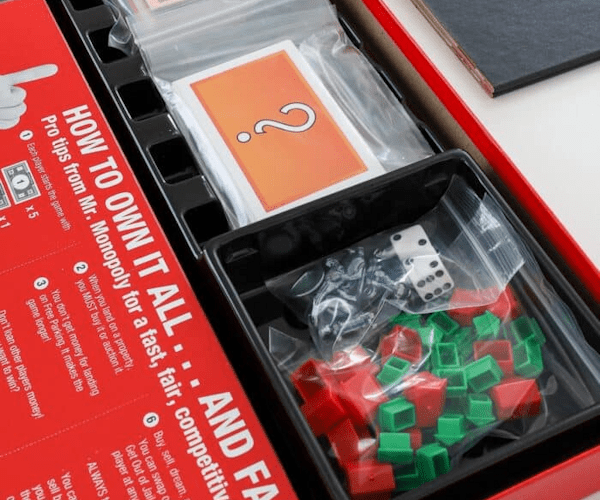
Component Management
Several companies have cropped up in our hobby that serve the need that is component management. These include The Broken Token, Folded Space, Game Trayz, literally dozens and dozens of vendors on Etsy, and more. The question I have is this: in the three decades since Catan started the modern board game revolution, should we need to rely on third-party purchases in order to keep our games safe and organized?
There are some box interiors that can make you cry. We all have seen games like Splendor and the sheer amount of vacant space within the box. But it is hardly alone, and this is not the only way to offend. If you look at something like Ra or Star Trek: Ascendancy, for instance, the interior is not helpful at all. In each of these cases, my game group and I had to purchase small plastic containers (Ra) or an entire tool-box (Ascendancy) with multiple layers and spaces to keep things somewhat organized. Ra just needed something to keep the point tokens organized. After a while, not everything for Ascendancy fit due to the complexity introduced with an ever-growing number of expansions.Someone at Gale Force Nine needed to think ahead a bit and figure out a solution to their game. They claim that their upcoming crowd-funding campaign will address this.
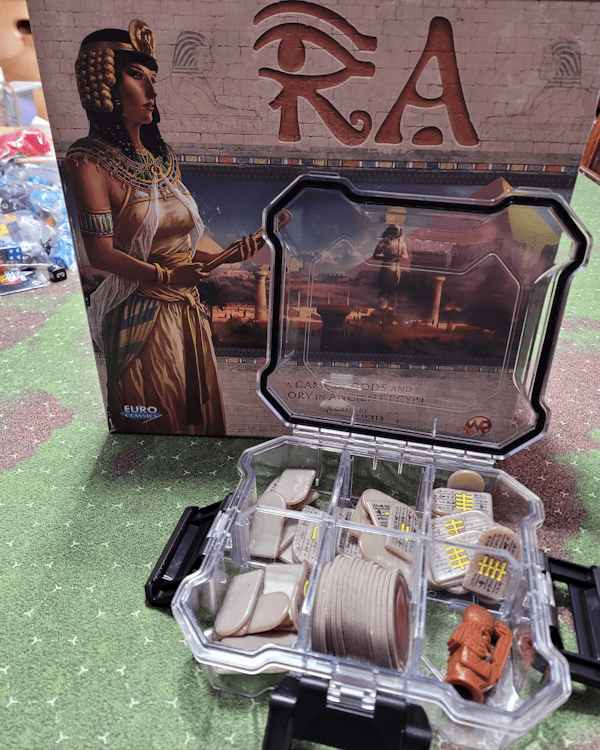
Currently, The Broken Token has 147 items to help you organize games; some of these are generic “card game” organizers, but most are set for a specific game. Additionally, they have 24 crates, organization solutions for games that have grown well past their original box and need a fully wooden solution all around. Folded Space has over 50 licensed organizers as a part of the nearly 150 organizers they have available. Game Trayz has an assortment of custom trays they have designed. The selection of things on Etsy is impossible to count.
The point is that it is a rarity to hear of a new game that contacted one of these companies and discussed how to organize the box prior to manufacturing the game. If they had done this, then the games could have shipped with a decent organizer and the need for the consumer to find a solution for storing the game would not be an issue. Even when a game company thinks about storage, they often come up short. Consider the fact that the game Red Rising has storage trays included. However, it seems that nobody tested these with the box stored on its end (as I, and a lot of other people, prefer to store games).
Size Isn’t Everything (but it is important)
When I first started following the modern Board Game market, I watched a lot of videos. In those videos, I saw a lot of people with beautiful shelves filled with games. I looked for those shelves and found that, more times than not, those are Kallax units from Ikea.This is not the only storage solution used by gamers, certainly, but it is a baseline from which we can work. With that, I want to make a declaration:
There is no reason that a game made today should
come in a box that cannot fit in a Kallax cubby. I mean
it. None. The interior dimensions of a Kallax shelving
cubby are 13¼×13¼×15⅜ inches. To make this easy,
let us say the maximum height or width of a modern
board game box should be 13 inches and the
maximum depth should be 15 inches.
I have the Deluxe Wooden Edition of Castle Panic. That box does not fit on my Kallax shelves, and I can attest to the fact that fully half of the space in that box is air. In other words, this box (despite coming with an organizer) is double the volume it needs to be. There is no reason this box should not fit in one of my cubbies other than to create the illusion of something far grander than what awaits inside. To some extent, the same can be said of my Collector’s Edition of Everdell. Or my Nesting Box for Wingspan. These boxes have a lot of stuff in them (and Wingspan has more to come), but they could have been better designed with an eye toward what sort of shelf would be needed to store these.
I can understand when some boxes are super large. My Designer Edition of Ogre is ginormous. And given the volume of content, I understand why. That said, had they divided the material into two boxes (i.e., the cardboard miniatures in one box, the maps and tokens in another) then this behemoth would not stick out from my shelves some 4-6 inches. It would be much easier to store.
And lift.
And get to the table.
I have three 5×5 Kallax units (two in the image below). I have many games that will not fit and have to be stacked on top.
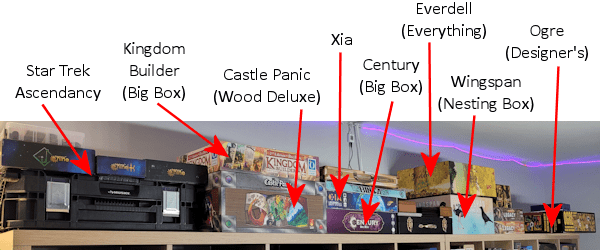
Since I have games like Empyreal: Spells and Steam and Gloomhaven and Dark Ages, and so on—all coming in really large boxes—which easily fit within Kallax cubbies, I think the game manufacturers can put some effort into making sure all these other games do as well.
Success Stories
Not all is lost! I recently received a gift of a game that wasn’t on my radar. The game is called Life in Reterra and it is one where there are a set of buildings (two small, two medium, and one large) that are chosen at the start. These are available to be constructed if the conditions are right on your player board. The game comes with three suggested sets of buildings (but you can mix and match them if you like). The game provides you with a beautiful tray to store each set and keep things organized. This is how it is done.
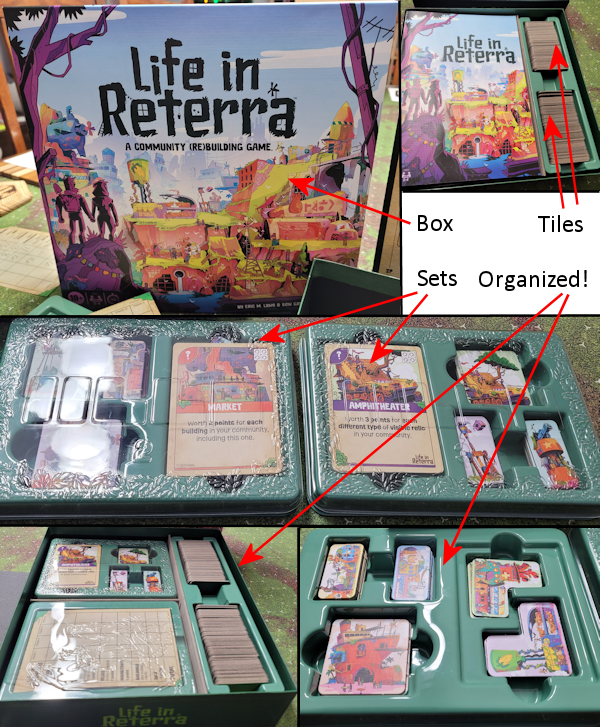
Everything, including the game tiles, buildings, scorepad, etc. has a nice place to keep it safe and sound and to make setup for the next play a breeze. No third-party purchase needed.
What this tells me is that there is hope.
I have seen other games where the designer and the manufacturer worked with a company like The Broken Token or Game Trayz (My Father’s Work) to design the component management system before shipping, to include that solution within the game when it goes to stores. It happens sometimes, and that it is a good thing.
It just needs to happen more often. This needs to be the rule, rather than the exception.
Thoughts
If game designers and manufacturers can be thoughtful and consider component organization and the limits of available shelving in mind, we might just be able to get a far better initial reaction to opening the box.
- Organization within the box, once you have opened things and punched out the pieces, needs to be more than an afterthought—or worse, considered as something that the customer needs to deal with. Sure, we might have been happy with buying a few boxes of snack-bags and sorting things that way back in the distant past of boardgaming. But games have gotten more complex, with a lot more pieces and a need to keep things separated. Hell, some games cannot really even be played without some kind of organizer (yes, I am looking at you, The Colonists).
- Beyond the organization inside the box, there is the consideration of where the consumer will store the game. And that means taking into consideration the realities of available shelving and the like. I am not saying Kallax is the be-all, end-all of game storage. I am saying that some thought needs to go into the size of the box and the methods available to store it. As a result, Kallax is not a bad starting point for this thinking process.It is like check-in luggage at the airport. There needs to be a storage unit at all the board game manufacturer’s facilities that has interior dimensions of 13×13×15 inches. A sign next to this unit needs to read:
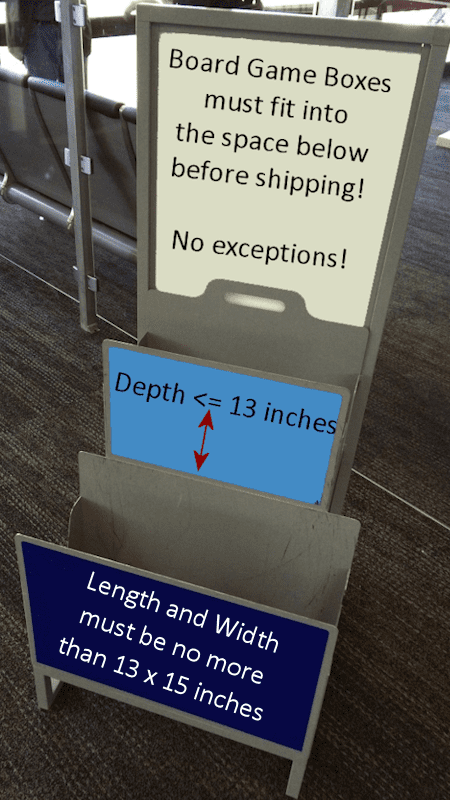
Perhaps the biggest offender I have seen recently is when I picked up Century: Big Box. This box contains the three games in the Century collection. The box is too large for a Kallax cubby, and the insert manages to give you the impression the box is simultaneously too large (i.e., it has a lot of wasted space) and too small (i.e., the 12 compartments manage to be insufficient for the number of separate components while not being able to store the player boards for two of the games — so those have to be stored on top of the insert, left to roam about the box unchecked).
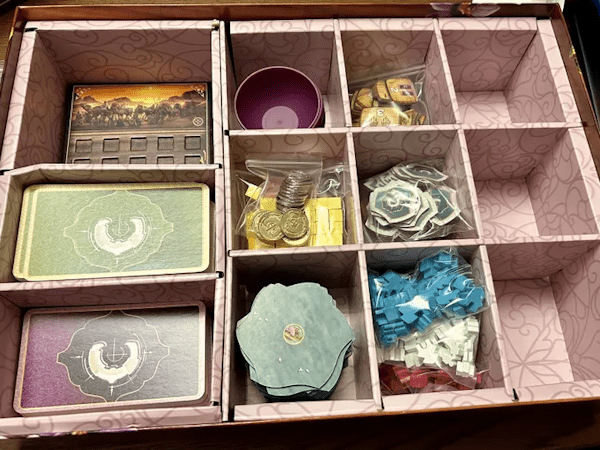
It boggles the mind that someone put so little thought into this. Aside from the obvious flaws in its sizing of storage spaces, it is also amazingly flimsy and cheap. I spent 2+ hours doing surgery on this thing and sorting the various components into snack bags before I was able to use it with any effectiveness. Even so, it is far from a proper insert. Someone should be ashamed. But as I said, there are examples of things done right. There is hope! This is a list of games that come with Game Trayz inside, for example.
Have you seen a game with a well designed organizer included? How about packaging that is exactly the size it needs to be? Let us know in the comments.


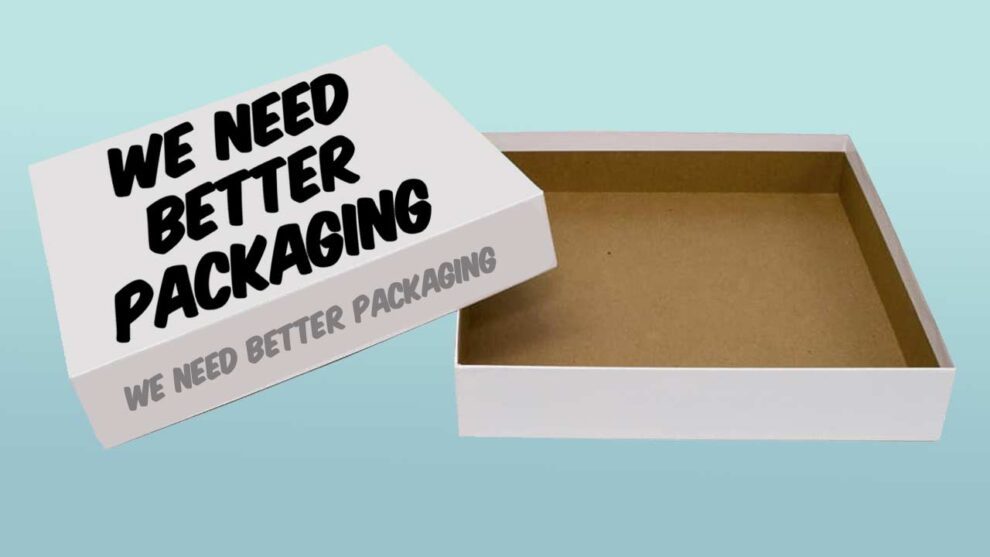






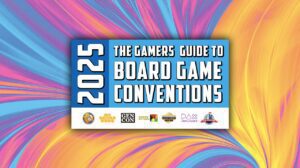
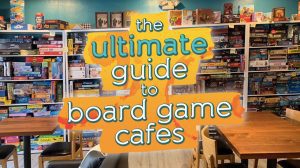
License to Krill fits in a very compact and portable plushie whale 🐋 “box”! Weasley fits in any kalax shelf.
1 game I love, Parks for the organization inside. Every time I open this game my eyes water at how amazing this box was put together, also you can flip it upside down store it on its side and everything doesn’t blow up and go everywhere. 2 more honorable mentions Architects of the west kingdom and Brass: Birmingham. While the inserts for these games are pretty not there, they both take up the exact amount of space they should. The box for both has about 0 air in them. Very good design. I’m so sick of games that sell air and therefore take up an unnecessary amount of space on my very limited shelf. Great article btw. Wish more game makers would read this article.
Soon as u saw the headline, I thought of splendor. I have a 3d printed box for that game that makes it easy to take to board game nights. We shouldn’t have to find our own solutions to these problems.
Most inserts are for shipping purposes to ensure components aren’t broken. That’s really the only function they need to provide.
Well designed inserts require:
– Someone with an understanding of the game to organize components usefully.
– Someone with the ability to make an organizer that makes good use of the box space.
– A price increase to include the additional costs of this work and produce the inserts.
While some GameTrayz are nice and thought out, others are often:
– The game Perfection where every bit has a unique spot, but no through was given to setup and gameplay.
– Wasted space since they need to fill the entire box to be useful. This also often makes them restrictive.
– Effectively garbage once an expansion comes out since the choice is either keep using the insert and have 2+ boxes for content or pitch the less useful parts of the insert and get rid of the expansion box.
Instead of needing a special space for everything and everything in it’s space, board gamers should be asking why a game needs so many components that the only way to play them is with the help of an insert. Games have gotten bloated, fiddly, and cludgy. Too many bits and not enough time refining the gameplay.
Additionally, a handful of games not fitting in a Kallax is fine. It’s a fairly restrictive shelving solution. Kallax being popular is hardly justification for publishers to cater to it.
The better question (outside of why a box of air), is why are these games so content bloated they need to be in a box that size. All I’ve heard from people that own the big box for Everdell is that it never gets to the table anymore. All the content and messing with the big box has diminished their enjoyment of the game. I’ve also pushed up against this problem with other games, where content bloat combined with an unwieldy box size reduce how much I play a game.
Many publishers will tell you that there are a few primary reasons for selecting a given box size. Two of the more common ones I’ve heard are:
1) Shelf presence – A box that is too small doesn’t stand out as much on the shelf, meaning that it won’t be as “in your face”. This is less important for online sales, but every little thing helps make a sale. And given that Walmart and Target still have huge game sections, it’s important to stand out.
2) Production consistency – If a publisher selects a previously used box size, it means then can more easily reuse digital files, potentially reuse dies to cut out boxes, etc. This lowers production costs and either makes the game cheaper, or allows the publisher to make more of a profit, or both.
Oh my! Thanks for all the comments! I appreciate all of your takes on this topic — the article is just my personal views. Seeing this level of engagement is amazing. It means a lot to me.
The best storage design I’ve ever seen is for Dice Forge. It’s a game with a number of unique components used for specific cards, and lots of small, finicky, potentially hard to organize pieces that slot into the chunky modular dice.
Firstly, it comes with a slotted board that all the die faces sit in, and a sleeve (with chunky elastic band) to hold the faces in for storage. Secondly, *everything else in the game has a slot in the box*. Even the tiny cardboard round marker has its own slot. Thirdly, all of the boards and player mats, though oddly shaped, have matching bits of oddly shaped plastic molded into the storage compartment, so everything sits comfortably in place without jostling around.
Quick, intuitive storage, complete with a diagram in the manual for how to pack it back in the box. Yes, the box is a significant amount larger than it strictly needs to be if everything were packed in plastic bags, but I’m willing to take that storage hit when the unboxing/reboxing experience is just SO GOOD.
Agreed. I picked up a copy of this one recently (I had only ever played it on BGA prior). Good game, good storage solution.
Honestly, the best storage solution is an empty box. It accommodates sleeved/unsleeved cards, custom pieces, expansions, and printouts—no insert will ever be flexible enough for this. Most inserts waste space, and I don’t have room for every game to store its components separately. Also, the Kallax obsession is bizarre—if you play anything outside of BGG’s Hotness or older titles, GOOD LUCK finding a ‘standard’ box size.
I (obviously) disagree. I think I see your point… but modern games are not such that a bunch of the small boxes from UHaul will work (at least not for me).
I have gone back and re-read my article three times… I am really not understanding the comments that suggest I am fixated on Kallax. I bring it up because it is popular. I bring it up because, when you are discussing shelf space, you need someplace to start — and this is a decent place to start. I have used other shelves from a variety of places (Walmart, Target, built by me, specialized furniture stores, etc.) and to be honest, Kallax seemed (and seems) like a decent starting point. But it is just that: a starting point. Nothing more.
When attempting to organize and store games (board games, role-playing games, and so on), unless you are going to throw everything into a closet, stacked atop each other, or you are going to invest in a few dozen milk crates or something… when discussing the collection storage itself, where would you start the discussion?
Well done, Sir!
I coudln’t agree more with everything you pointed out.
Look at the Rhino Hero Super Battle – it’s 80% empty box and that box is also oversized, whyyyyy…
Better situation with my favorite game: 7 Wonders Duel – insert is good, everything sorted, looks nice… but as card quality is not too good, we sleeved them – now they don’t fit the tray, whyyyyy…
Very good example of good box size is Red Cathedral. Amazingly big game in such a small box. Bravo! There is no organizer inside, on the down side, sadly.
There’s a strange direction with cardboard compartments inside box as in Flamecraft. Those get distorted easily and don’t actually help much. That, for me, feels fake and cheap and diminishes the game.
Best thing is that there is a feeling of evolution. That brings up hope and joy to my heart.